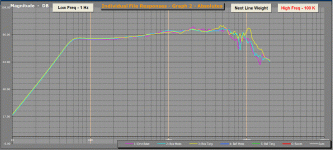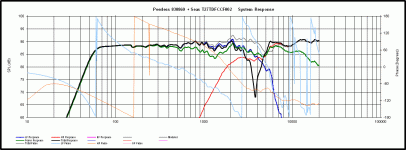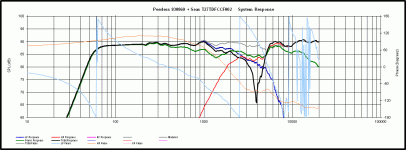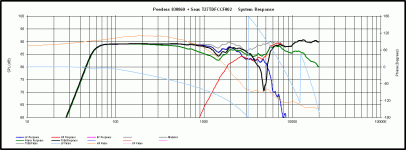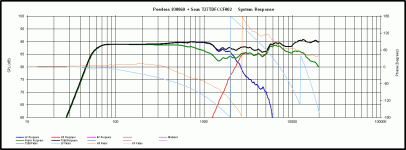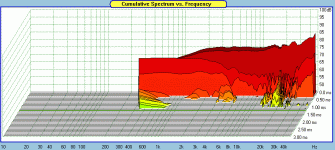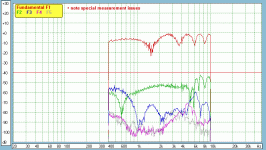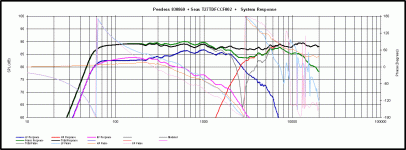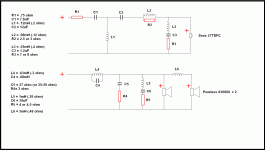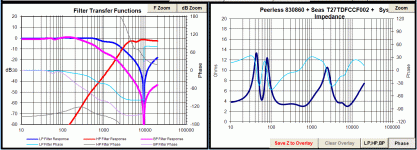David Ralph has one:
http://speakerdesign.net/raw/zip/raw_27tdfc.zip
Note mic distance is 0.5 m, therefore SPL is +6 dB.
http://speakerdesign.net/raw/zip/raw_27tdfc.zip
Note mic distance is 0.5 m, therefore SPL is +6 dB.
You are right, I used a measurement published in the german loudspeaker magazine KLANG+TON, but that's only a minor difference and does not really explain, why you get a rising frequency response towards 1 kHz and I get a falling one.
It's evident to me that simulation programs differ in calculation of bass reflex and edge diffraction. For example, my program is very much in accordance with the vented box simulations of WinISD, but quite different from some results of BassBox Pro I have seen. The calculation of edge diffraction is even more uncertain, because there is no known exact solution. The programs simply use various approximation methods which are more or less accurate. I hope that explains, why you can't expect two different simulations to yield identical results.
Much simpler than SPL is the calculation of impedance and filter transfer functions, and the results therefore should be quite close. But a comparison of the actual woofer filter transfer functions reveals a difference of more than 1 dB at 1 kHz, and that's too much IMO. This difference is not new to me, as I have encountered similar deviations of PCD a few times in the past. As a verification of my program showed a full agreement with Boxsim, I assume a little bug in some versions of PCD, but I don't know.
I don't at all say my program is better. I even honestly admit the simulated SPL in the range of 700 Hz - 2 kHz is often 1-2 dB lower than measured. On the other hand, your simulation always seems to have the microphone on axis of each driver, which neglects actual driver spacing. Nobody is perfect.
Thanks Dissi, that's an excellent answer to my question.
I had to go through all my files a 2nd time looking unsuccessfully for errors before I realized that the difference between our sims was primarily in the woofer's upper midrange response which is exactly where vvindir thinks he's having a problem so I figure it's kind of important in this case. From my understanding, Peerless is usually pretty good with their measurements but I don't doubt at all that they may be a little off. Right now I am going to use the raw measurements that Troel's took of the driver on his cabinet, swap out the different baffle diffraction effects and see how that compares.
BTW, PCD does use the drivers' on-axis response but then, in the set-up, it does take into account all the relative distances between drivers and their acoustic centers.
vvinder, if you are interested, here are the differences (1st graph) between Peerless' measurement, Troels' and Klang & Ton's. The graphs include baffle diffraction and 6dB of baffle step loss. Peerless is violet, Troels is blue and K&T is yellow
The differences may look minor but notice that the dB scale to the left is fairly compressed in this graph. Compared to Peerless, Troels' measured a tiny bit more energy at 1kHZ and a fair amount less between about 2k and 4kHz, while K&T measured less at 1k and 2kHz but much more at 5k and about 10kHz (the resonances).
I find this interesting because it changes what your original xo would look like depending on which FR you use and would therefore also alter the identification of your original upper midrange harshness problem. Whereas in the first graph I posted with your original xo that used Peerless' measurements (posted again, 2rd graph), it looked like the peak at 2kHz might have been the problem. Now with Troels' measurements (3rd graph), it looks like the peak around 1kHz might be it although really, that doesn't look large enough to be causing you so much grief. If you use K&T's measurements then there doesn't appear to be a problem in the upper midrange now at all (4th graph).
What I think might help you is to try a bit more of a methodical approach and try to identify exactly where you are hearing a problem from. I would 1st try to identify if it's the woofer or tweeter by maybe going back to your 1st xo and playing the woofers disconnected from the tweeter and then vice-versa. Then if you can identify which driver it is, maybe try some tone sweeps or individual tone bursts to further isolate the problem. If you can't do it any other way, WinISD has a tone generating function in it. Try to determine if the problem is at 1kHz? At 2kHz? Or is it the resonance at either 5k or 9kHz or both? Or is it the tweeter? Or all of the above? Something like that anyways. Without being able to measure your own speaker, that might tell you which of the 3 measured FR's might be the closest to what you're hearing and should be used in any further sims.
Now in terms of the speaker lacking clarity, if you look at all 3 sims, notice that the xo frequency range within which both the tweeter and the woofers are contributing to the summed output is actually quite large - say about 1.8k to 4kHz - and that's largely due to the shape of the tweeter response. And notice too that the drivers are badly out of phase in this region. Those 2 together is a big problem - it means your ears are hearing the same frequencies from 2 different sources but they are arriving at different times. Not good. And the large spacing between the bottom woofer and the tweeter probably isn't helping in that regard either.
No disrespect intended toward Dissi, but after all the effort it looks like you put in on your cabinet, I would want to get the best I could out of the drivers and so I would still want to go with a 2.5-way for your baffle configuration even if it is a little harder to simulate and will result in a higher parts count. I'll post something I've come up with using Troels' measurements shortly.
The differences may look minor but notice that the dB scale to the left is fairly compressed in this graph. Compared to Peerless, Troels' measured a tiny bit more energy at 1kHZ and a fair amount less between about 2k and 4kHz, while K&T measured less at 1k and 2kHz but much more at 5k and about 10kHz (the resonances).
I find this interesting because it changes what your original xo would look like depending on which FR you use and would therefore also alter the identification of your original upper midrange harshness problem. Whereas in the first graph I posted with your original xo that used Peerless' measurements (posted again, 2rd graph), it looked like the peak at 2kHz might have been the problem. Now with Troels' measurements (3rd graph), it looks like the peak around 1kHz might be it although really, that doesn't look large enough to be causing you so much grief. If you use K&T's measurements then there doesn't appear to be a problem in the upper midrange now at all (4th graph).
What I think might help you is to try a bit more of a methodical approach and try to identify exactly where you are hearing a problem from. I would 1st try to identify if it's the woofer or tweeter by maybe going back to your 1st xo and playing the woofers disconnected from the tweeter and then vice-versa. Then if you can identify which driver it is, maybe try some tone sweeps or individual tone bursts to further isolate the problem. If you can't do it any other way, WinISD has a tone generating function in it. Try to determine if the problem is at 1kHz? At 2kHz? Or is it the resonance at either 5k or 9kHz or both? Or is it the tweeter? Or all of the above? Something like that anyways. Without being able to measure your own speaker, that might tell you which of the 3 measured FR's might be the closest to what you're hearing and should be used in any further sims.
Now in terms of the speaker lacking clarity, if you look at all 3 sims, notice that the xo frequency range within which both the tweeter and the woofers are contributing to the summed output is actually quite large - say about 1.8k to 4kHz - and that's largely due to the shape of the tweeter response. And notice too that the drivers are badly out of phase in this region. Those 2 together is a big problem - it means your ears are hearing the same frequencies from 2 different sources but they are arriving at different times. Not good. And the large spacing between the bottom woofer and the tweeter probably isn't helping in that regard either.
No disrespect intended toward Dissi, but after all the effort it looks like you put in on your cabinet, I would want to get the best I could out of the drivers and so I would still want to go with a 2.5-way for your baffle configuration even if it is a little harder to simulate and will result in a higher parts count. I'll post something I've come up with using Troels' measurements shortly.
Attachments
About measuring drivers, isnt the most correct one the one with the room as close to a normal listening environment?
I have some bad experience with tonegenerators Instead i use blackmetal music (the kind witch is well produced) to reveal an imbalanced speaker very quick. But blackmetal sound harsh either way you say, no thats not the case.
Instead i use blackmetal music (the kind witch is well produced) to reveal an imbalanced speaker very quick. But blackmetal sound harsh either way you say, no thats not the case.
As my good ears have found out, the problems is with the tweeter down at around 2000-2500hz. Can some tricks in the crossover fix the phaseproblem with the drivers?
My current crossover are similar to Dissi's, but with another highpass-part, witch i got from x-over 3, feeding the tweeter low just dont work i believe. This is the best setup so far, and the sensivity is great. What is exiting is that i used a better cap for the woofer this time, before i used 33uf metal foil 63v from by Mcap, now i use poly-cap rated 250volt, and it obviusly sound better.
I have some bad experience with tonegenerators
 Instead i use blackmetal music (the kind witch is well produced) to reveal an imbalanced speaker very quick. But blackmetal sound harsh either way you say, no thats not the case.
Instead i use blackmetal music (the kind witch is well produced) to reveal an imbalanced speaker very quick. But blackmetal sound harsh either way you say, no thats not the case. As my good ears have found out, the problems is with the tweeter down at around 2000-2500hz. Can some tricks in the crossover fix the phaseproblem with the drivers?
My current crossover are similar to Dissi's, but with another highpass-part, witch i got from x-over 3, feeding the tweeter low just dont work i believe. This is the best setup so far, and the sensivity is great. What is exiting is that i used a better cap for the woofer this time, before i used 33uf metal foil 63v from by Mcap, now i use poly-cap rated 250volt, and it obviusly sound better.
Dissi,
I must say that I am very impressed with your knowledge of the software you and I are using. Below is your xo values using K&T's FR measurements of the 830860 with PCD. Very similar to your results with your program except in the say, 700Hz to 1200Hz region. If I use 1.2mH on the woofer instead of 1mH, that difference mostly goes away. Very interesting.
vvindir,
Yes, getting the phase aligned at the xo region is 1 of the strong advantages of a simulation program. I'm not really doubting your ears, but I'm puzzled why that Seas tweeter should be having problems in the 2k to 2.5kHz region. Its resonant frequency is still 2 octaves below that (550Hz). Its harmonic distortion is very good above 2000Hz (2nd graph) and it has no bad resonances in that area (3rd graph). Seas suggests usable FR down to 1500Hz.
Still, I guess 4th order acoustic around 2.5k to 2.8kHz might be the way to go for you without getting too close to the 5kHz resonance on the woofer. I'll see what I can come up with.
I must say that I am very impressed with your knowledge of the software you and I are using. Below is your xo values using K&T's FR measurements of the 830860 with PCD. Very similar to your results with your program except in the say, 700Hz to 1200Hz region. If I use 1.2mH on the woofer instead of 1mH, that difference mostly goes away. Very interesting.
vvindir,
Yes, getting the phase aligned at the xo region is 1 of the strong advantages of a simulation program. I'm not really doubting your ears, but I'm puzzled why that Seas tweeter should be having problems in the 2k to 2.5kHz region. Its resonant frequency is still 2 octaves below that (550Hz). Its harmonic distortion is very good above 2000Hz (2nd graph) and it has no bad resonances in that area (3rd graph). Seas suggests usable FR down to 1500Hz.
Still, I guess 4th order acoustic around 2.5k to 2.8kHz might be the way to go for you without getting too close to the 5kHz resonance on the woofer. I'll see what I can come up with.
Attachments
vvindir,
FWIW, here's what I've come up with for a 2.5-way xo for you. This time I'm using the FR that Troels measured for the 830860's so the summed response will look a little different when this xo is used with the Klang & Ton measurements. The xo on the tweeter is 4th order acoustic and about 3rd order on the woofer. Xo point is at about 2600Hz. The response of the bottom woofer is down about 25dB at the xo point this time. Impedance minima are again about 3ohms.
I included a bit of a dip in the xo region for you like Dissi did hoping that will take care of the problem you're having in that frequency range. The phase is very nicely aligned right across the whole FR, so that should hopefully help in the clarity department.
To let you know, L2/R2 is a contour filter that pulls down the tweeter's rising response above about 5kHz. L3/C3/R3 is notching out a wicked peak at about 6kHz. I think both are necessary with this xo.
The little cap C4 with L4 is creating the deep notch at about 9kHz to pull down that resonance in the woofer and finally L5/C6/R5 is another notch filter similar to what Troels used on his 830860 version to pull down the rising response at about 1kHz.
Sorry, there's a fair number of new parts but many of them are fairly small values so they don't have to be expensive. But using higher quality caps for C1 and C2 on the tweeter may also help with the harshness problem you're having and so may be worth it.
And you should be able to notice that sensitivity remains high, at about 87dB.
Hope that helps
FWIW, here's what I've come up with for a 2.5-way xo for you. This time I'm using the FR that Troels measured for the 830860's so the summed response will look a little different when this xo is used with the Klang & Ton measurements. The xo on the tweeter is 4th order acoustic and about 3rd order on the woofer. Xo point is at about 2600Hz. The response of the bottom woofer is down about 25dB at the xo point this time. Impedance minima are again about 3ohms.
I included a bit of a dip in the xo region for you like Dissi did hoping that will take care of the problem you're having in that frequency range. The phase is very nicely aligned right across the whole FR, so that should hopefully help in the clarity department.
To let you know, L2/R2 is a contour filter that pulls down the tweeter's rising response above about 5kHz. L3/C3/R3 is notching out a wicked peak at about 6kHz. I think both are necessary with this xo.
The little cap C4 with L4 is creating the deep notch at about 9kHz to pull down that resonance in the woofer and finally L5/C6/R5 is another notch filter similar to what Troels used on his 830860 version to pull down the rising response at about 1kHz.
Sorry, there's a fair number of new parts but many of them are fairly small values so they don't have to be expensive. But using higher quality caps for C1 and C2 on the tweeter may also help with the harshness problem you're having and so may be worth it.
And you should be able to notice that sensitivity remains high, at about 87dB.
Hope that helps
Attachments
Think he ment 0.68uF instead of 0.68 mH
Yes you be tired
Correct.
Sheesh again........
Okay, then i ordered some small components.
Kondensator Polypropylen 0,68uF
Kondensator Polyester 22uF
Motstand Trådviklet 0,68ohm
Spole Luft 0,47mH 0,8mm tråd
Spole P-Kjerne 3,3mH 1,2mm
2x everything
I'll pay for your 2x if you pay for my 2x active DSP 4 channel mtmmmmm, power supplies and all
Phonar
By the way, here is a speaker that use similar components. Its claimed crossovers are 700/2800hz. Hmm interesting.
[Review] Phonar Veritas P4 Next loudspeakers - [English]
By the way, here is a speaker that use similar components. Its claimed crossovers are 700/2800hz. Hmm interesting.
[Review] Phonar Veritas P4 Next loudspeakers - [English]
- Status
- This old topic is closed. If you want to reopen this topic, contact a moderator using the "Report Post" button.
- Home
- Loudspeakers
- Multi-Way
- peerless & seas 2-way
